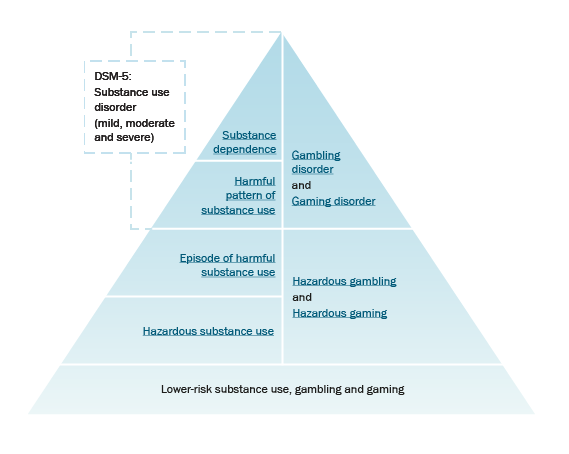Terminology for substance use and addictive behaviours
Disorders due to substance use and addictive behaviours are classified by the Diagnostic and Statistical Manual of Mental Disorders 5th edition (DSM-5) and the International Classification of Diseases 11th Revision (ICD-11) international categorisation systems. Terms used in these guidelines are based on ICD-11 because the criteria for prescribing in disorders of substance use under the Pharmaceutical Benefits Scheme (PBS) use ICD-11 terminology.
Both DSM-5 and ICD-11 describe a spectrum of disorders of substance use. DSM-5 uses the term ‘substance use disorder’, with criteria for classification into ‘mild’, ‘moderate’ and ‘severe’ disorders1. ICD-11 describes a broader spectrum of severity, dividing the equivalent of DSM-5 ‘substance use disorder’ into ‘harmful pattern of substance use’ and ‘substance dependence’—for criteria, see ICD-11 classification of substance use.
In describing the spectrum of addictive behaviours, both DSM-5 and ICD-11 recognise ‘gambling disorder’ as an addictive behaviour. DSM-5 criteria are available at the American Psychiatric Association website. ICD-11 distinguishes between ‘gambling disorder’ and ‘hazardous gambling’; it also includes ‘hazardous gaming’ and ‘gaming disorder’—for criteria, see ICD-11 classification of addictive behaviour.
[NB1]

DSM-5 = Diagnostic and Statistical Manual of Mental Disorders 5th edition; ICD-11 = International Classification of Diseases 11th Revision
NB1: Labels in the pyramid are ICD-11 diagnoses, other than the category ‘lower-risk substance use, gambling and gaming’. The ‘lower-risk’ category is not a diagnostic term but is used here to illustrate the full spectrum of substance use and addictive behaviours. Proportions for each classification are not represented to scale. Corresponding DSM-5 terms for substance use are shown on the left of the diagram.
